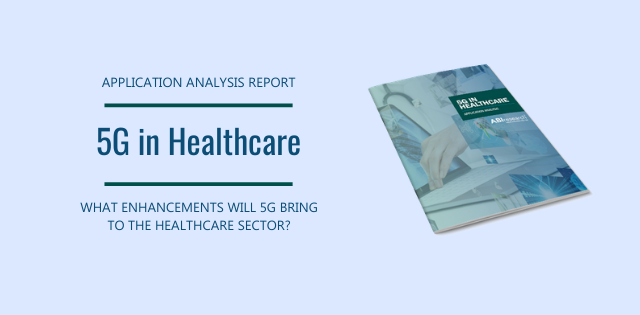Undoubtedly the industry most dramatically affected by COVID-19, healthcare systems across the globe are under tremendous pressure and the pandemic highlights an urgent need to advance toward smart healthcare systems. At the same time, COVID-19 has also presented the perfect application scenario for the deployment of 5G networks in hospitals, doctors’ practices, and social care environments. By 2026, we forecast that 5G will generate US$399.8 million (at a 2021-2026 CAGR of 137%) in revenues in the healthcare domain with a total of 4.6 million 5G connections.
Modernizing Healthcare
Considerations about how to modernize healthcare systems by strengthening remote services have led public authorities to realize the importance of healthcare system modernization. The Federal Communication Commission (FCC) in the United States is releasing US$200 million for telehealth applications, while Chinese regulators decided on unified national standards for 5G networks in the healthcare sector.
These numbers underscore the huge momentum that we see for 5G adoption in the healthcare domain. By providing enhanced mobile broadband, ultra-reliable low latency, and massive machine type communication, 5G will be an important building block for smarter and more efficient healthcare systems.
Early Success in China
Having realized the importance of modernizing healthcare infrastructure, the COVID-19 outbreak has accelerated 5G network deployment in hospitals especially in the hardest-hit regions, such as China. By providing sufficient bandwidth through enhanced mobile broadband capabilities, the deployment of a 5G network allowed the introduction of remote diagnostic and consultation facilities within hospitals in China, to prevent patients potentially infected with COVID-19 from having to leave their house to get medical consultation and a preliminary diagnosis. By enabling remote consultation, 5G significantly contributed to the reduction of COVID-19 infection rates, preventing countless numbers of lives lost in China.
Recommendations for MNOs and Infrastructure Vendors
To drive adoption of cellular connectivity in the healthcare sector, MNOs (mobile network operators) should focus their primary efforts on the private healthcare sector. Private healthcare providers are more sensitive about efficiency enhancements and potential cost savings that result from these enhancements, so the private healthcare sector will be easier to convince about the benefits of a 5G-enabled smart healthcare system.
Also, decision-making structures in the private sector, and therefore investment decisions, are considerably easier than in the public healthcare sector. Therefore, MNOs should target private healthcare as a first step toward realizing increased 5G revenue. Subsequently, MNOs can then break into public healthcare using experiences of the private sector as a key asset. In targeting the public sector portion of healthcare providers, MNOs need to remember that a successful targeting needs to address both public bodies (as these ultimately will make investment decisions), as well as healthcare providers (e.g., hospital operators).
To guarantee that the cellular network can interoperate with currently existing standards for patient data management, MNOs need to deploy the cellular Network-as-a-Platform (NaaP) that allow specialized software companies to develop healthcare specific applications. Furthermore, offerings for the healthcare sector should adopt an Everything-as-a-Service (XaaS) approach, to depart from monetizing connectivity as the sole component.
Infrastructure vendors should offer packaged solutions to healthcare providers to simplify decision processes. Even though the nature of packaging requires some standardization of solutions, there should be customizable options (e.g., different package sizes). Vendors must make manufacturing priorities their own and create an ecosystem to address all implementer requirements, from devices to support services.
To increase the appetite for the deployment of cellular connectivity in the healthcare sector, vendors should create reliable business blueprints and offer easy-to-deploy trial kits. These allow healthcare professionals and providers to get accustomed with deploying cellular connectivity without having to commit to long-term deployment projects upfront.
Much like MNOs, infrastructure vendors need to adjust their pricing models to remove entry barriers for potential implementers and aid 5G deployment in the healthcare sector. To be able to afford this, vendors and MNOs must cooperate to agree on revenue sharing models.
How Healthcare Providers Can Help
To drive 5G adoption in the sector, healthcare providers need to refine their understanding of the variety of enhancements that 5G will bring to the healthcare system to assess how these efficiency improvements translate into monetizable benefits.
Prior to deploying a cellular network on-premises, healthcare providers need to decide on the specific deployment option, using either shared spectrum or licensed spectrum directly from the regulator (whenever possible) or side with an MNO for network operation. Furthermore, healthcare providers need to be fully aware of the implications of each deployment option.
To accelerate the trend toward a smart and connected healthcare system, public authorities need to understand their responsibility in formulating unified regulations to provide the necessary unified framework that pushes healthcare providers (especially in the public sector) to deploy cellular connectivity for healthcare applications.
Public authorities need to understand that the benefits of a smart healthcare system (better quality healthcare, translating to a lower number of preventable deaths) will ultimately benefit the overall society. Therefore, to foster the adoption of smart and automated healthcare systems, public authorities need to accept their responsibility to provide the necessary investment.
A Look Ahead
Despite the tremendous opportunities that 5G brings to the healthcare domain, particularly through the operation of private cellular networks, network operators and infrastructure vendors need to understand, that these deployment projects do not happen overnight.
Rather, it needs the consolidated effort of network operators and infrastructure vendors to develop innovative business models based on managed services instead of just selling connectivity. ABI Research forecasts that by 2026, the majority of 5G revenues will be generated by a combination of managed services, while only 45% of revenues will come from monetizing connections. To be successful in the healthcare domain, telco monetizing strategies need to reflect this change to preserve their spot in the 5G value chain.





